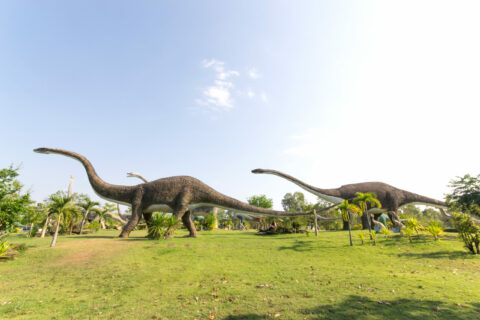Climate change at Triassic-Jurassic boundary played a key role in the evolution of dinosaurs
FAU-led team of paleontologists publish latest findings on the development of dinosaurs in Current Biology
201 million years ago, the Earth got so hot that it caused a mass extinction of animals and other animate beings. For dinosaurs on the other hand, this climate change was actually beneficial: Their populations started growing and they expanded their habitat. This is shown in the research results of an international team of scientists led by Friedrich-Alexander-Universität Erlangen-Nürnberg (FAU), the Universities of Birmingham and Bristol in the UK as well as the University of São Paulo in Brazil. The findings have now been published in the scientific journal Current Biology.*
Global warming supported growth of dinosaur population
How did the dinosaurs become the dominant species of their time? Even today, we still do not know all of the details concerning their evolution and biodiversity. However, paleontologists at FAU as well as from the universities in Birmingham, Bristol and São Paulo have discovered a new piece of the puzzle. Previous investigations suggested that dinosaurs simply outcompeted other large reptiles living at this time, but more recent studies examining sauropodomorphs, the ancestors to long-necked sauropods like Brachiosaurus, propose that climate might have been a factor in driving their evolutionary success.
This study now has brought together data concerning all dinosaur species including paleogeographical information on fossil distribution, spatially-explicit general climate models and evolutionary tree-based statistical analyses to explore the links between dinosaur diversity and climate. “What we see in our results suggests that instead of dinosaurs being outcompeted by other large vertebrates, it was variations in climate conditions that were restricting their diversity before the Triassic-Jurassic mass extinction,” explains FAU paleontologist Dr. Emma Dunne, who is the main author of the published paper. While the climate near the equator in the Late Triassic was much too warm for early dinosaur species, when the climate zones shifted in the early Jurassic, this allowed dinosaur species’ population to flourish and expand to new areas that were previously inaccessible. “The results were somewhat surprising, because it turns out that sauropods were really particular about what climate zones they lived in from the get-go: later in their evolution they continue to stay in warmer areas and avoid polar regions.”
The next step: Dinosaurs of the Jurassic and Cretaceous periods
For their research, the scientists compared models of prehistoric global climate conditions such as temperature and rainfall at the different habitats of dinosaurs back then. The necessary data was taken from sources such as the Paleobiology Database. However, the project is not finalized yet: In order to evaluate the impact of the climate on dinosaurs during the following 120 million years, the Jurassic and Cretaceous periods, the team will continue their work using similar methods.
*For the full paper, see: https://doi.org/10.1016/j.cub.2022.11.064
Weitere Informationen
Dr. Emma Dunne
Chair of Palaeontology
Tel.: 09131 85 22967
emma.dunne@fau.de
If you would like to explore the aforementioned Paleobiology Database, follow this link: www.paleobiodb.org/navigator
